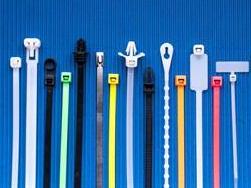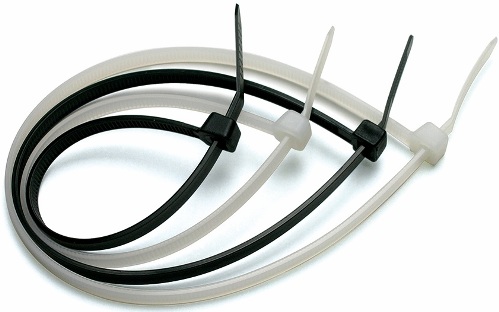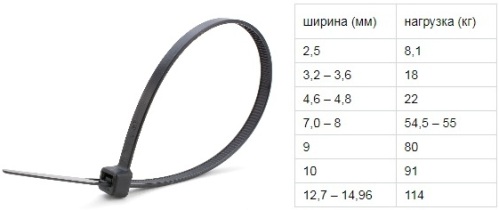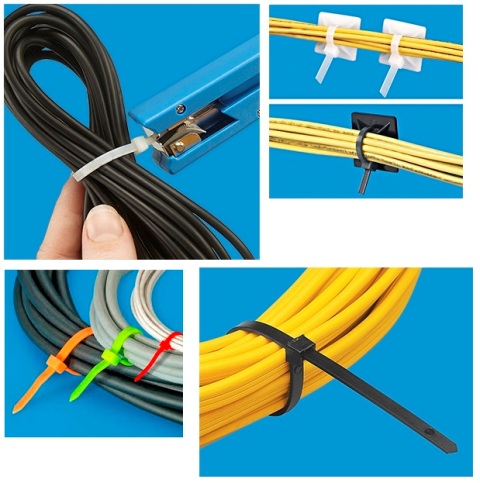Categories: Electric installation work
Number of views: 15093
Comments on the article: 0
Cable ties and their use
 In order to mark, fasten or assemble cables during electrical installation, it is very convenient and advantageous to use cable ties. These plastic clamps allow you to quickly, safely and efficiently complete the installation of the cable system in compliance with high quality and reliability requirements.
In order to mark, fasten or assemble cables during electrical installation, it is very convenient and advantageous to use cable ties. These plastic clamps allow you to quickly, safely and efficiently complete the installation of the cable system in compliance with high quality and reliability requirements.
These products are called differently today: cable ties, nylon cable ties, cable ties, plastic ties - we are always talking about the same product, the very first sample of which was invented and patented back in 1958 in the United States by Sir Maurus Logan, Thomas & Betts, a design engineer at the time, was manufacturing cable for submarines and aircraft.
The idea came to the inventor from scratch. Initially, cables on aircraft and submarines tied one to another with a thread soaked in wax, knitted with knots, passing the thread between the individual wires. If repair was required, the threads were cut, and after the repair new knits were knitted - everything happened very laborious and inconvenient.
And so, on one warm evening, when Maurus was resting on the lawn of one of the city parks, he noticed a blade of grass that sprouted through another blade of grass, in which an insect had gnawed a hole, and a twig lay in this loop made of grass ...
A brilliant thought was not long in coming. Soon, a new type of clamp was used by Boeing, and was successfully tested under various conditions, including air, sea, army, etc. The trade name of the clamp was Ty-Rap.

To date, clamps in the form of flexible strips made of durable nylon-66, superior in strength even to some of the metals, have found very wide application in the electrical industry around the world.
Nylon clamps are used for various purposes: for fixing cables inside devices, for fastening cables on load-bearing structures, for forming bundles of wires, for fastening harnesses on guide racks and cabinets, on load-bearing cables, for forming loops, and just for fixing the cable in place input to the junction box.

Cable ties vary in width and length, respectively, and the maximum load that the coupler is capable of bearing on itself varies. Lengths from 60 to 120 mm allow you to choose a cable tie for working with wires and with bundles of wires of different diameters.
By combining the screed with each other, you can get a composite screed of greater length. The wider the screed - the greater the permissible load on it. The table above shows the characteristic maximum loads for screeds of different widths.
For various external conditions, screeds are available for indoor use or for outdoor installation. Screeds for outdoor use are made according to a complicated recipe: stabilizers are added to the screed material to increase resistance to ultraviolet, high humidity, high temperature and other destructive external influences.
Ultraviolet has the most detrimental effect on nylon, therefore, as a stabilizer for all-weather screeds, they add carbon powder - it is black in color, because the all-weather screed turns out black (meanwhile, not all black screeds are necessarily all-weather).

As for the internal screeds (for indoor use), they are multicolored - to give aesthetics to the room, to distinguish the bundles of wires for the purpose, finally satisfy the taste of the electrician himself (everyone likes his own colors).
By design, cable ties are divided into non-opening (disposable) and unlockable (reusable).By installing once the screed, you can open it only by cutting it, but the reusable screed can be opened and fixed again many times.
Disposable clamps allow you to reliably and quickly collect wires in bundles or fix wires on structures. If the bundle or cable turns out to be of a large diameter, then several couplers can be combined to obtain a clamp of the required length. In this way, almost any task associated with the installation of cables is solved.

There are protrusions on one side of the screed, and a lock on the other. To obtain a strong and reliable fixation, the screed is simply tightened and there is no way back. To dismantle - you have to cut it and just throw it away. But this does not matter, the cost of such couplers is cheap compared to their functionality, so it is economically justified.
The clamp is tightened either by hand or with a special tool with a trigger, which, by the way, immediately cuts off the excess protruding tail of the screed right near the lock. Tightening force is set directly on the tool. The use of the tool will reduce installation time and ensure high quality and productivity.
For outdoor use, screeds made of material resistant to high temperatures (up to 121 ° C) are used. There are couplers with fixing holes, with anchor fastening, marking (with a marking pad), with a nameplate, reusable with a special lock with the possibility of reuse, ball, ball with a nameplate and detachable ball.
If it is necessary to fix the clamp on a smooth surface, then it is necessary to use a special self-adhesive or screed pad for screws. For installation on concrete, brick or wood, resort to the use of dowels.
Various external factors, of course, affect cable ties, and some of them greatly reduce cable ties: acids, exceeding the maximum allowable mechanical load, vibration (leads to cracks), a large amount of ultraviolet (when operating at height), 100% humidity reduces strength, dryness or frost makes screeds brittle. Use the screed correctly!
See also at bgv.electricianexp.com
:
